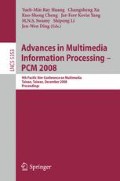Abstract
An approach to the problem of illumination variations in face detection that uses classifier fusion is presented. Multiple face detectors are seperately trained for different illumination environments and their results are combined using a combination rule. To define the illumination environments, the training samples are clustered based on their illumination using unsupervised training. Different methods of clustering the samples and combining the outputs of the classifiers are examined. Experiments with the AR face database show that the proposed method achieves higher accuracy than the traditional monolithic face detection method.
Access this chapter
Tax calculation will be finalised at checkout
Purchases are for personal use only
Preview
Unable to display preview. Download preview PDF.
References
Adini, Y., Moses, Y., Ullman, S.: Face recognition: The problem of compensating for changes in illumination direction. IEEE Transactions on Pattern Analysis and Machine Intelligence 19(7), 721–732 (1997)
Belhumeur, P.N., Kriegman, D.J.: What is the set of images of an object under all possible lighting conditions? In: IEEE Conference on Computer Vision and Pattern Recognition, pp. 270–277. IEEE Computer Society, Los Alamitos (1996)
Bílek, P., Matas, J.: Illumination independent object recognition: A survey. Technical Report TR-2001-30, Center for Machine Perception, Faculty of Electrical Engineering, Czech Technical University, Prague, Czech Republic (October 2001)
Friedman, J., Hastie, T., Tibshirani, R.: Additive logistic regression: a statistical view of boosting. Annals of Statistics 28(2), 337–407 (2000)
Georgiev, T.: Relighting, retinex theory and perceived gradients. In: Mirage 2005, Ricquencourt, France, INRIA (March 2005)
Gonzalez, R.C., Woods, R.E.: Digital Image Processing, 2nd edn. Prentice Hall, Englewood Cliffs (2002)
Gross, R., Brajovic, V.: An image preprocessing algorithm for illumination invariant face recognition. In: International Conference on Audio- and Video-Based Biometric Person Authentication, Guildford, UK, June 2003, pp. 10–18. Springer, Heidelberg (2003)
Hara, K., Nishino, K., Ikeuchi, K.: Light source position and reflectance estimation from a single view without the distant illumination assumption. IEEE Transactions on Pattern Analysis and Machine Intelligence 27(4), 493–505 (2005)
Jones, M., Viola, P.: Fast multi-view face detection. Technical Report TR2003-096, Mitsubishi Electric Research Laboratories (August 2003)
Kuncheva, L.I.: Combining Pattern Classifiers: Methods and Algorithms. Wiley-Interscience, Hoboken (2004)
Lee, D.D., Seung, H.S.: Learning the parts of objects by nonnegative matrix factorization. Nature 401(6755), 788–791 (1999)
Li, S.Z., Zhu, L., Zhang, Z.Q., Blake, A., Zhang, H.J., Shum, H.: Statistical learning of multi-view face detection. In: European Conference on Computer Vision, London, UK, pp. 67–81. Springer, Heidelberg (2002)
Li, W.-J., Wang, C.-J., Xu, D.-X., Chen, S.-F.: Illumination invariant face recognition based on neural network ensemble. In: IEEE International Conference on Tools with Artificial Intelligence, Washington, DC, USA, pp. 486–490. IEEE Computer Society, Los Alamitos (2004)
Li, Y., Gong, S., Sherrah, J., Liddell, H.: Multi-view face detection using support vector machines and eigenspace modelling. In: International Conference on Knowledge-Based Intelligent Engineering Systems and Allied Technologies, vol. 1, pp. 241–244 (2000)
Lin, Y.-Y., Liu, T.-L.: Robust face detection with multi-class boosting. In: IEEE Conference on Computer Vision and Pattern Recognition, vol. 1, pp. 680–687. IEEE Computer Society, Los Alamitos (2005)
Marschner, S.R., Greenberg, D.P.: Inverse lighting for photography. In: IS&T/SID Color Imaging Conference: Color Science, Systems and Applications, Scottsdale, Arizona, USA, pp. 262–265 (November 1997)
Martinez, A.M., Benavente, R.: The AR face database. Technical Report 24, CVC (UAB) (June 1998)
Okabe, T., Sato, I., Sato, Y.: Spherical harmonics vs. Haar wavelets: Basis for recovering illumination from cast shadows. In: IEEE Conference on Computer Vision and Pattern Recognition, vol. 1, pp. 50–57. IEEE Computer Society, Los Alamitos (2004)
Ramamoorthi, R., Hanrahan, P.: On the relationship between radiance and irradiance: Determining the illumination from images of a convex Lambertian object. Journal of the Optical Society of America 18(10), 2448–2458 (2001)
Rowley, H.A., Baluja, S., Kanade, T.: Neural network-based face detection. IEEE Transactions on Pattern Analysis and Machine Intelligence 20(1), 23–38 (1998)
Schneiderman, H., Kanade, T.: A statistical method for 3D object detection applied to faces and cars. In: IEEE Conference on Computer Vision and Pattern Recognition. IEEE Computer Society, Los Alamitos (2000)
Torralba, A., Murphy, K.P., Freeman, W.T.: Sharing features: efficient boosting procedures for multiclass object detection. In: Computer Vision and Pattern Recognition (CVPR), vol. 2, pp. 762–769. IEEE Computer Society, Los Alamitos (2004)
Viola, P., Jones, M.: Rapid object detection using a boosted cascade of simple features. In: IEEE Conference on Computer Vision and Pattern Recognition, vol. 1, pp. 511–518. IEEE Computer Society, Los Alamitos (2001)
Wang, H., Li, S.Z., Wang, Y.: Face recognition under varying lighting conditions using self quotient image. In: International Conference on Automatic Face and Gesture Recognition, pp. 819–824. IEEE Computer Society, Los Alamitos (2004)
Author information
Authors and Affiliations
Editor information
Editors and Affiliations
Rights and permissions
Copyright information
© 2008 Springer-Verlag Berlin Heidelberg
About this paper
Cite this paper
Cordiner, A., Ogunbona, P., Li, W. (2008). Illumination Invariant Face Detection Using Classifier Fusion. In: Huang, YM.R., et al. Advances in Multimedia Information Processing - PCM 2008. PCM 2008. Lecture Notes in Computer Science, vol 5353. Springer, Berlin, Heidelberg. https://doi.org/10.1007/978-3-540-89796-5_47
Download citation
DOI: https://doi.org/10.1007/978-3-540-89796-5_47
Publisher Name: Springer, Berlin, Heidelberg
Print ISBN: 978-3-540-89795-8
Online ISBN: 978-3-540-89796-5
eBook Packages: Computer ScienceComputer Science (R0)

